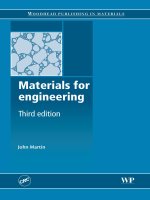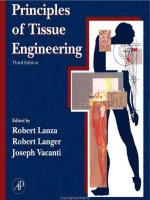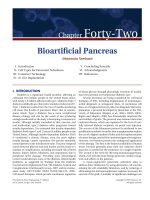Materials for engineering, 3rd edition (malestrom)
Bạn đang xem bản rút gọn của tài liệu. Xem và tải ngay bản đầy đủ của tài liệu tại đây (3.45 MB, 269 trang )
Woodhead Publishing Ltd
Abington Hall
Abington
Cambridge CB1 6AH
England
www.woodheadpublishing.com
ISBN-13: 978-1-84569-157-8
ISBN-10: 1-84569-157-1
CRC Press LLC
6000 Broken Sound Parkway, NW
Suite 300
Boca Raton
FL 33487
USA
CRC order number WP8780
ISBN-10: 0-8493-8780-9
Materials for
engineering
John Martin
‘Outstanding academic title for 2003 – this title has been selected for its
excellence in scholarship and presentation, the significance of its contribution to
the field, and because of its important treatment of its subject.’
Choice magazine
This third edition of what has become a modern classic presents a lively overview
of materials science for students of structural and mechanical engineering. It
contains chapters on the structure of engineering materials, the determination
of mechanical properties, and the structure – property relationships of metals and
alloys, glasses and ceramics, organic polymeric materials and composite materials.
It contains a section with 50 thought-provoking questions to check students’
knowledge and understanding, as well as a series of useful appendices. The third
edition includes new topics such as superplasticity and the Bauschinger Effect,
expanded coverage of such areas as organic polymers and updated reading lists.
Clear, concise and authoritative, the third edition of Materials for engineering
will confirm its position as an ideal text for undergraduates and a useful reference
source on materials structure and properties for the practising engineer.
John Martin is Emeritus Reader in Physical Metallurgy at the University of Oxford
and recipient of the Platinum Medal of the UK Institute of Materials, Minerals and
Mining.
Materials for engineering
Martin
Woodhead Publishing and Maney Publishing
on behalf of
The Institute of Materials, Minerals & Mining
Third edition
Third edition
3
m
I
The Institute of Materials, Minerals & Mining
14
mm
234 x 156 / 307 C & 3025 C
Materials for engineering
Related titles:
Solving tribology problems in rotating machines
(ISBN-13: 978-1-84569-110-3; ISBN-10: 1-84569-110-5)
Bearings are widely used in rotating machines. Understanding the factors affecting their
reliability and service life is essential in ensuring good machine design and performance.
Solving tribology problems in rotating machines reviews these factors and their implications
for improved machine performance.
Nanostructure control of materials
(ISBN-13: 978-1-85573-933-8; ISBN-10: 1-85573-933-X)
Nanotechnology is an area of science and technology where dimensions and tolerances in
the range of 0.1 nm to 100 nm play a critical role. Nanotechnology has opened up new
worlds of opportunity. It encompasses precision engineering as well as electronics,
electromechanical systems and mainstream biomedical applications in areas as diverse as
gene therapy, drug delivery and novel drug discovery techniques. This new book provides
detailed insights into the synthesis/structure and property relationships of nanostructured
materials. A valuable book for materials scientists, mechanical and electronic engineers and
medical researchers.
Engineering catastrophes, 3rd edn
(ISBN-13: 978-1-85573-505-7; ISBN-10: 1-85573-505-9)
This new edition of a well received and popular book contains a general update of historical
data, more material concerning road and rail accidents and, most importantly, a new chapter
on the human factor. The author provides a broad survey of the accidents to which engineering
structures and vehicles may be subject. Historical records are analysed to determine how
loss and fatality rates vary with time and these results are displayed in numerous graphs and
tables. Notable catastrophes such as the sinking of the Titanic and the Estonia ferry disaster
are described. Natural diasters are considered generally, with more detail in this edition on
earthquake resistant buildings.
Details of these and other Woodhead Publishing materials books and journals, as well as
materials books from Maney Publishing, can be obtained by:
• visiting www.woodheadpublishing.com
• contacting Customer Services (e-mail: ;
fax: +44 (0) 1223 893694; tel.: +44 (0) 1223 891358 ext. 30; address:
Woodhead Publishing Ltd, Abington Hall, Abington, Cambridge CB1 6AH, England)
If you would like to receive information on forthcoming titles, please send your address
details to: Francis Dodds (address, tel. and fax as above; email: francisd@woodhead-
publishing.com). Please confirm which subject areas you are interested in.
Maney currently publishes 16 peer-reviewed materials science and engineering journals.
For further information visit www.maney.co.uk/journals.
Woodhead Publishing and Maney Publishing
on behalf of
The Institute of Materials, Minerals & Mining
CRC Press
Boca Raton Boston New York Washington, DC
W
OODHEAD
PUBLISHING
LIMITED
Cambridge England
Materials for
engineering
J. W. Martin
Third edition
Woodhead Publishing Limited and Maney Publishing Limited on behalf of
The Institute of Materials, Minerals & Mining
Woodhead Publishing Limited, Abington Hall, Abington,
Cambridge CB1 6AH, England
www.woodheadpublishing.com
Published in North America by CRC Press LLC, 6000 Broken Sound Parkway, NW,
Suite 300, Boca Raton, FL 33487, USA
First published 1996.
Second edition published 2002 by Maney Publishing for The Institute of Materials
Third edition published 2006, Woodhead Publishing Limited and CRC Press LLC
© Woodhead Publishing Limited, 2006
The author has asserted his moral rights.
This book contains information obtained from authentic and highly regarded sources.
Reprinted material is quoted with permission, and sources are indicated. Reasonable
efforts have been made to publish reliable data and information, but the author and
the publishers cannot assume responsibility for the validity of all materials. Neither
the author nor the publishers, nor anyone else associated with this publication, shall
be liable for any loss, damage or liability directly or indirectly caused or alleged to be
caused by this book.
Neither this book nor any part may be reproduced or transmitted in any form or by
any means, electronic or mechanical, including photocopying, microfilming and
recording, or by any information storage or retrieval system, without permission in
writing from Woodhead Publishing Limited.
The consent of Woodhead Publishing Limited does not extend to copying for
general distribution, for promotion, for creating new works, or for resale. Specific
permission must be obtained in writing from Woodhead Publishing Limited for such
copying.
Trademark notice: Product or corporate names may be trademarks or registered
trademarks, and are used only for identification and explanation, without intent to
infringe.
British Library Cataloguing in Publication Data
A catalogue record for this book is available from the British Library.
Library of Congress Cataloging in Publication Data
A catalog record for this book is available from the Library of Congress.
Woodhead Publishing Limited ISBN-13: 978-1-84569-157-8 (book)
Woodhead Publishing Limited ISBN-10: 1-84569-157-1 (book)
Woodhead Publishing Limited ISBN-13: 978-1-84569-160-8 (e-book)
Woodhead Publishing Limited ISBN-10: 1-84569-160-1 (e-book)
CRC Press ISBN-10: 0-8493-8780-9
CRC Press order number: WP8780
The publishers’ policy is to use permanent paper from mills that operate a
sustainable forestry policy, and which has been manufactured from pulp
which is processed using acid-free and elementary chlorine-free practices.
Furthermore, the publishers ensure that the text paper and cover board used
have met acceptable environmental accreditation standards.
Typeset by Replika Press Pvt Ltd, India
Printed by TJ International, Padstow, Cornwall, England
Contents
Preface to the third edition ix
Preface to the second edition xi
Preface to the first edition xiii
Introduction xv
Part I Characterization of engineering materials
1 Structure of engineering materials 3
1.1 Crystal structure 3
1.2 Microstructure 7
1.3 Molecular structure of organic polymers and glasses 27
1.4 Further reading 35
2 Determination of mechanical properties 37
2.1 Introduction 37
2.2 The tensile test 37
2.3 Bend testing 43
2.4 Statistics of brittle fracture 45
2.5 Hardness testing 45
2.6 Fracture toughness testing 47
2.7 Time-dependent mechanical properties 52
Part II Structure–property relationships
3 Metals and alloys 71
3.1 General strengthening mechanisms: the effect of processing 71
3.2 The families of engineering alloys 84
3.3 Joining of metals and alloys 115
Contentsvi
3.4 Degradation of metals and alloys 122
3.5 Further reading 131
4 Glasses and ceramics 133
4.1 Glasses 133
4.2 Glass ceramics 138
4.3 Ceramic materials 139
4.4 Cement and concrete 147
4.5 Bulk metallic glasses 156
4.6 Further reading 158
5 Organic polymeric materials 159
5.1 Introduction 159
5.2 Forming processes for polymers 161
5.3 Directionality of properties 163
5.4 Mechanical properties 163
5.5 Joining of polymers 175
5.6 Polymer degradation 179
5.7 Modelling of polymer structure and properties 182
5.8 Further reading 184
6 Composite materials 185
6.1 Introduction 185
6.2 Manufacture of composite materials 186
6.3 Cellular solids 191
6.4 Modelling composite behaviour 194
6.5 Further reading 214
Part III Problems
Chapter 1 problems 219
Chapter 2 problems 221
Chapter 3 problems 224
Chapter 4 problems 226
Chapter 5 problems 226
Chapter 6 problems 227
Part IV Appendices
I Useful constants 231
II Conversion factors 233
III Selected data for some elements 235
IV Sources of material property data 237
V The Periodic Table of the elements 241
Index 243
Contents vii
Preface to the third edition
The criterion I have adopted for discussing a specific material in this book
is its commercial availability, rather than its being confined to a research and
development laboratory. In the ten years since the appearance of the first
edition of the book, a number of such engineering materials have appeared
on the market and a number of these will be discussed in the pages below.
I have also taken the opportunity of including a few topics of engineering
importance that were originally omitted. Typical examples are the phenomena
of superplasticity and the Bauschinger Effect. The chapter on organic polymeric
materials now includes a fuller introduction to the range of those commercially
available, and their typical applications.
The suggested reading lists at the end of chapters have been updated
where necessary, as has the Appendix devoted to a review of the sources of
material property data (though the latter is essentially a moving target and so
can never be fully comprehensive!).
I continue to appreciate with gratitude the support and encouragement of
my colleagues notably that of Professor George Smith, FRS, for allowing me
access to the facilities of the Department of Materials at the University of
Oxford.
John W. Martin
Since the appearance of the first edition of the book, it has been pointed out
to me that its value to the student reader would be increased if a series of
related problems were included. Over 50 such problems have been devised,
and they appear at the end of the text.
The opportunity has also been taken to correct a number of misprints and
errors which appeared in the earlier edition. I am particularly indebted to
Professor Christopher Viney of Heriot-Watt University for his assistance in
this regard.
Preface to the second edition
Preface to the first edition
This textbook represents an attempt to present a relatively brief overview of
Materials Science, the anticipated readership being students of structural and
mechanical engineering. It is in two sections – the first characterising
engineering materials, the second considering structure–property relationships.
Emphasis is thus placed on the relationship between structure and properties
of materials, starting with the concept of ‘structure’ at three levels – crystal
structure, microstructure, and molecular structure. The discussion of
microstructure introduces the topics of phase transformations, metallography
and phase diagrams – none of which would be familiar to the intended readership.
After a section on the determination of mechanical properties, the remaining
four chapters deal with the four important classes of engineering materials,
namely metals, ceramics, polymers and composites. It is estimated that there
are some 40 000 metallic alloys in existence, over 5000 polymers and some
2000 ceramic materials, so there is some justification in discussing metals
and alloys at the greatest length. In that chapter, an attempt has been made
to consider initially the general principles of strengthening, so that the individual
families of engineering alloys can be discussed in the light of this introduction.
About equal emphasis is placed on the remaining classes of materials.
The tables of data within the text, and the Appendices, have been selected
to increase the value of the book as a permanent source of reference to the
readers throughout their professional life. The latter include:
Useful constants
Unit conversion factors
Selected data for some elements
A list of sources of material property data, in the form of both handbooks
and database software.
The Periodic Table of the elements
The author is pleased to acknowledge the encouragement and suggestions
given by the members of the University Books Sub-Committee of the Institute
of Materials, Minerals & Mining. I am also most grateful to Professors B.
Cantor and D. G. Pettifor, FRS, for the facilities they have kindly provided
for me in the Oxford University Department of Materials and to Peter
Danckwerts for his efficient dealing with editorial matters.
Introduction
The materials available to engineers for structural applications embrace an
extremely wide range of properties. We can classify them into THREE broad
families as follows:
METALS & ALLOYS
ENGINEERING CERAMICS & GLASSES
ENGINEERING POLYMERS & ELASTOMERS
There is the further possibility that materials from two or more of these
families may themselves be combined to form a FOURTH family, namely:
COMPOSITE MATERIALS
It is possible to present a broad ‘overview’ of the properties of engineering
materials by constructing a Material Property Chart. These charts show the
relationship between two selected engineering properties of the above families,
and Fig. 0.1 (due to Ashby) illustrates the Young’s modulus–density chart for
engineering materials.
Young’s elastic modulus is one of the most self-evident of material properties,
reflecting as it does the stiffness of structural steel or the compliance of
rubber. Because of this wide range of values, the scales of the axes in
Fig. 0.1 are logarithmic, and their ranges have been chosen to include all
materials from light polymeric foams to engineering alloys.
Data for a given family of materials are seen to cluster together on the
chart, and each family has been enclosed within an envelope in the diagram.
Although each class of material has characteristic properties, these may vary
within each class because of variations in structure at three different levels,
namely the atomic arrangement, or crystal structure, the microstructure,
which refers to the size and arrangement of the crystals, and the molecular
structure. We will consider these aspects of structure in turn.
Introductionxvi
0.1 Young’s modulus,
E
, vs. density,
ρ
. (After M. F. Ashby,
Acta
Metall.
,
1989, 37, 1273).
Young’s modulus,
E
(GPa)
1000
100
10
1
0.1
0.01
0.1 0.3 1.0 3.0 10 30
Density,
ρ
(Mg/m
3
)
1. Modulus–Density
Young’s modulus
E
(
G
= 3
E
/8 :
K
=
E
)
MFA: 88-91
10
4 Parallel
to grain
Ash
Oak
Pine
Fir
Balsa
3 × 10
3
Woods
WC-Ce
Engineering
ceramics
Steels
Engineering
composites
Laminates
GFRP KFRP
KFRP
GFRP
CFRP
Glasses
Sialons
Si
BeO
ZrO
2
Aluminas
Diamond
B
SiCSi
3
H
4
W-alloys
Mo
Cu-alloys
Zn-alloys
Tin
alloys
Lead
alloys
Ni-alloys
Ce
Pottery
Ti-alloys
Al-alloys
Rock, stone
Cement, concrete
Mg-
alloys
Porous
ceramics
Engineering
alloys
Wood
products
MEL
P
PS
Epoxies
PMMA
PVC
Nylon
Polyesters
HDPE
PTFE
LDPE
Plasticised
PVC
Guide lines for
minimum
weight design
Soft
butyl
Polymers
foams
Cork
3 × 10
2
Hard
butyl
PU
10
3
Lower limit
for true solids
Perpendicular
to grain
Ash
Oak
Pine
Fir
Spruce
Balsa
PP
CFRP
uni-ply
E
ρ
1/2
(m / s)
E
C
ρ
=
E
C
1/3
=
ρ
Elastomers
E
C
1/2
=
ρ
Silicone
Part I
Characterization of engineering materials
3
1.1 Crystal structure
Crystal structure refers to the ordering of atoms into different crystalline
arrangements. It is the arrangement of these atoms – the strength and
directionality of the interatomic bonds – which determines the ultimate strength
of the solid. Techniques involving X-ray or electron diffraction are employed
to determine crystal structures, and four types of interatomic bonding are
recognized: van der Waals, covalent, ionic and metallic. The latter three
‘primary’ bonds are limiting cases, however, and a whole range of intermediate
bonding situations also exist in solids.
The van der Waals force is a weak ‘secondary’ bond and it arises as a
result of fluctuating charges in an atom. There will be additional forces if
atoms or molecules have permanent dipoles as a result of the arrangement of
charge inside them. In spite of their low strength, these forces can still be
important in some solids; for example it is an important factor in determining
the structure of many polymeric solids.
Many common polymers consist of long molecular carbon chains with
strong bonds joining the atoms in the chain, but with the relatively weak van
der Waals bonds joining the chains to each other. Polymers with this structure
are thermoplastic, i.e. they soften with increasing temperatures and are readily
deformed, but on cooling they assume their original low-temperature properties
and retain the shape into which they were formed.
Covalent bonding is most simply exemplified by the molecules of the
non-metallic elements hydrogen, carbon, nitrogen, oxygen and fluorine. The
essential feature of a covalent bond is the sharing of electrons between
atoms, enabling them to attain the stable configuration corresponding to a
filled outermost electron shell. Thus, an atom with n electrons in that shell
can bond with only 8 – n neighbours by sharing electrons with them.
For example, when n = 4, as in carbon in the form of diamond, one of the
hardest materials known, each atom is bonded equally to four neighbours at
the corners of a regular tetrahedron and the crystal consists of a covalent
1
Structure of engineering materials
Materials for engineering4
molecule, Fig.1.1(a). In graphite, only three of the four electrons form covalent
bonds, so a layer structure forms, Fig. 1.1(b), and the fourth electron is free,
which gives some metallic properties to this form of carbon. Graphite crystals
are flat and plate-like, and they are so soft that graphite is used as a lubricant.
It is clear from Fig. 1.1 that the different dispositions of the covalent bonds
in space have a profound influence on the atomic arrangements and hence
upon properties of the material.
For many years diamond and graphite were the only known forms of
carbon, but, in 1985, a new form of carbon (buckminsterfullerene), C
60,
was
identified, Fig. 1.1(c), as a soccer-ball-like cage of 60 carbon atoms with a
diameter of 0.71 nm. This was the only allotrope of any element to have been
discovered in the twentieth century. Other, larger, fullerene ‘buckeyballs’
have subsequently been discovered and, in 1991, multiwalled carbon nanotubes
were discovered. Two years later, single-walled carbon nanotubes were
discovered with diameters generally varying between 1.3 and 1.6 nm. Figure
1.1(d) is an electron micrograph showing a series of fullerene buckeyballs
within a carbon nanotube. Carbon nanotubes can be synthesized by a number
of techniques, including carbon arcs, laser vaporization and ion bombardment.
1.1
Crystal structure of (a) diamond; (b) graphite; (c) buckminsterfullerene,
C
60
; and (d) electron micrograph of a series of buckeyballs within a
carbon nanotube: a diagram of the structure is shown underneath.
(Courtesy Dr Andrei Khlobystov.)
(c)
(a) (b)
(d)
5 nm
Structure of engineering materials 5
They consist of concentric, cylindrical, graphitic carbon layers capped on
the ends with fullerene-like domes.
The possibility of encapsulating atoms (and molecules) inside the fullerene
cages is of considerable interest, giving rise to materials with highly modified
electronic properties and thus opening the way to novel materials with unique
chemical and physical properties. The Young’s modulus of multiwalled
nanotubes has been measured to be 1.26 TPa and this high strength may be
exploited by incorporating them in composite materials.
The elements can be divided into two classes, electronegative elements
(such as oxygen, sulphur and the halogens) that tend to gain a few electrons
to form negatively charged ions with stable electron shells, and electropositive
elements (such as metals) that easily dissociate into positive ions and free
electrons. Ionic bonding consists of an electrostatic attraction between positive
and negative ions. If free atoms of an electropositive element and an
electronegative element are brought together, positive and negative ions will
be formed which will be pulled together by electrostatic interaction until the
electron clouds of the two ions start to overlap, which gives rise to a repulsive
force. The ions thus adopt an equilibrium spacing at a distance apart where
the attractive and repulsive forces just balance each other.
Figure 1.2 shows a diagram of the structure of a sodium chloride crystal:
here each Na
+
ion is surrounded by six Cl
–
ions and each Cl
–
is surrounded
by six Na
+
ions. Many of the physical properties of ionic crystals may be
accounted for qualitatively in terms of the characteristics of the ionic bond;
for example they possess low electrical conductivity at low temperatures,
but good ionic conductivity at high temperatures. The important ceramic
Na Cl
1.2
Crystal structure of sodium chloride.
Materials for engineering6
materials consisting of compounds of metals with oxygen ions are largely
ionically bonded (MgO, Al
2
O
3
, ZrO
2
, etc).
Metallic bonding. About two-thirds of all elements are metals, and the
distinguishing feature of metal atoms is the looseness with which their valence
electrons are held. Metallic bonding is non-directional and the electrons are
more or less free to travel through the solid. The attractions between the
positive ions and the electron ‘gas’ give the structure its coherence, Fig. 1.3.
The limit to the number of atoms that can touch a particular atom is set by
the amount of room available and not by how many bonds are formed.
‘Close-packed’ structures, in which each atom is touched by twelve others,
are common and they give rise to the typical high density of metals. Since
each atom has a large number of neighbours, the overall cohesion is strong
and metals are therefore similar to ionic and covalent solids as regards
strength and melting point.
In general, the fewer the number of valence electrons an atom has and the
more loosely the electrons are held, the more metallic the bonding. Such
elements have high electrical and thermal conductivities because their valence
electrons are so mobile. Although a satisfactory description of some of the
physical properties of metals can be obtained from this ‘free electron’ picture,
many other properties (particularly those concerned with the motion of electrons
within metal crystals) have to be explained in terms of electrons as waves
occupying definite quantized energy states.
As the number of valence electrons and the tightness with which they are
held to the nucleus increase, they become more localized in space, increasing
the covalent nature of the bonding. Group IVB of the Periodic Table illustrates
particularly well this competition between covalent and metallic bonding:
diamond exhibits almost pure covalent bonding, silicon and germanium are
more metallic, tin exists in two modifications, one mostly covalent and the
other mostly metallic, and lead is mostly metallic.
Nucleus plus
inner electrons
Electron cloud
1.3
Classical model of a metal crystal.
Structure of engineering materials 7
1.2 Microstructure
Microstructure refers to the size and arrangement of the crystals, and the
amount and distribution of impurities in the material. The scale of these
features is typically 1–100 µm. Microstructure determines many of the
properties of metals and ceramics.
1.2.1 Introduction to phase transformations
The transition from the liquid state to the solid state is known as ‘crystallization’,
and the mechanism by which the process takes place controls the microstructure
of the final product. A phase transformation, such as the change from liquid
to solid, occurs by the mechanism of nucleation of small ‘seed’ crystals in
the liquid, which then grow by the addition of more material from the liquid.
The driving force for this change can be obtained by considering the change
in free energy on solidification. For example, if a liquid is undercooled by
∆T below its melting point (T
m
) before it solidifies, solidification will be
accompanied by a decrease in the Gibbs free energy of ∆G. The Gibbs free
energy of a system is defined by the equation
G = H – TS
where H is the enthalpy, T the absolute temperature and S the entropy of the
system. The free energies of the liquid and solid at temperature T are given
by
G
L
= H
L
– TS
L
G
S
= H
S
– TS
S
so that at temperature T, the change in free energy/unit volume upon
solidification may be written:
∆G
v
= ∆H – T∆S [1.1]
where ∆H = H
L
– H
S
and ∆S = S
L
– S
S
At the equilibrium melting temperature T
m
, ∆G
v
= 0, thus
∆S = ∆H/T
m
= L/T
m
[1.2.]
where L is the latent heat of fusion. Combining equations [1.1] and [1.2]
gives
∆G
v
= L – T(L/T
m
)
Thus, for an undercooling ∆T,
∆G
v
= L∆T/T
m
[1.3]
Materials for engineering8
Equation [1.3] shows that the higher the degree of supercooling, the greater
the free energy decrease, and this is a most useful result to which we will
return.
Nucleation
Consider a given volume of liquid supercooled below T
m
by a temperature
interval ∆T. If a small sphere of solid forms (radius r), the free energy of the
system will be lowered by an amount per unit volume corresponding to
equation [1.3]. Energy is required, however, to create the solid/liquid interface,
of energy
γ
SL
per unit area. The free energy change in the system may be
written:
∆G = –(4/3)πr
3
∆G
v
+ 4πr
2
γ
SL
[1.4]
Figure1.4 illustrates this relationship and it may be seen that, for a given
undercooling, there is a certain critical radius, r
c
, of the solid particle. Solid
particles with r < r
c
, known as embryos, will redissolve in the liquid to lower
the free energy of the system, whereas particles with r > r
c
, known as nuclei,
will grow in order to decrease the energy of the system.
By differentiation of equation [1.4] it can be shown that:
r
c
= 2γ
SL
/∆G
v
[1.5]
∆
G
0
Interfacial
energy ∝
r
2
∆
G
*
r
c
∆
G
r
Volume free
energy ∝
r
3
∆
T
1.4
Free energy change associated with the nucleation of a sphere of
radius
r
.









